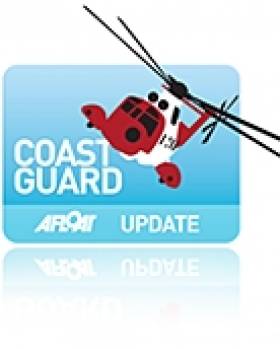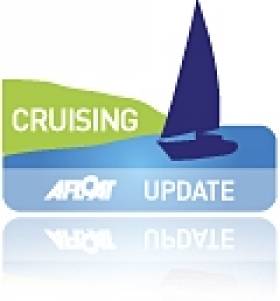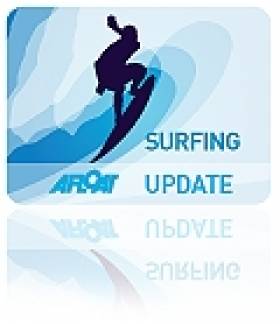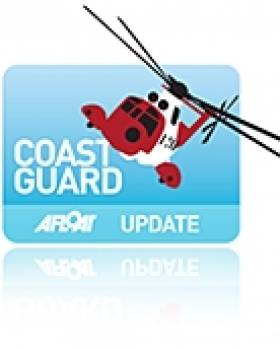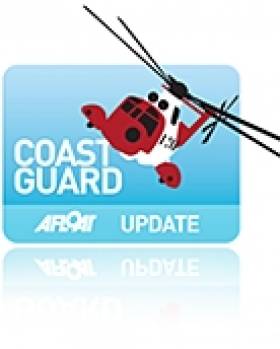Displaying items by tag: Coast
Irish Coasts Vulnerable to Climate Change
Bray, Co Wicklow was the location for a unique Climate Change event on Friday (20th November) hosted by Seán Kelly MEP on the importance of achieving a global deal to reduce carbon emissions in Paris next month.
"I am honoured to have been chosen to be part of the delegation that will represent the European Parliament at the global UN Climate Change Conference in Paris in December and will be the only Irish MEP to do so. We received our mandate with a huge majority from the Parliament last month and we are ready to work in Paris to get our key points across," Mr Kelly told attendees.
"Climate Change is truly one of the key challenges of this century. Failure to address it effectively will result in major adverse impacts that will affect all countries.
"Ireland, for example, is particularly vulnerable to loss of coastal assets due to rising sea levels, along with increased precipitation and the resulting flood risks - all of these would prove hugely costly, both socially and economically.
"The bottom line is, we need an ambitious and binding global agreement and we will push for that in Paris. If EU ambition is matched globally, we keep jobs and economic growth here, while meeting the 2oC objective," the MEP added.
Climate change is a cross sector challenge according to Mr Kelly which requires a concerted global effort. "We need to take action to limit these temperature increases, but we have a challenge to do so while meeting the parallel challenges of ensuring food security and maintaining EU competitiveness."
"The bottom line is, we need an ambitious and binding global agreement and we will push for that in Paris. If EU ambition is matched globally, we keep jobs and economic growth here, while meeting the 2oC objective," he said.
Event speakers included Jean-Pierre Thebault, French Ambassador to Ireland, Eamon Ryan, Leader of the Green Party, Mauro Poinelli, Head of Unit Environment, Forestry and Climate Change, European Commission, who examined the agricultural side of the debate and Neil Walker, IBEC’s Head of Infrastructure, Energy and Environment who presented the Irish business perspective.
Stormy Autumn Contributed To Record 2014 Coast Guard Response Statistics
#coastguard – The Coast Guard has seen a record response for 2014, with it being particularly relevant to the Shannon SAR Helicopter who flew the Bases 300th mission last week. As Afloat.ie already reported two days ago, the Coast Guard attributes the rise in the number of incidents to:
1. Prolonged warm weather during the summer
2. More people taking holidays in Ireland (which are normally taken near water)
3. Additional work undertaken by the Coast Guard helicopters assisting the national ambulance service, particularly with medevacs of patients suffering from Strokes and STEMIS - ST Segment Elevation Myocardial Infarction
4. Storms and High winds in the early part of the year and coming into Autumn
The Coast Guard believes that the rise in the number of incidents shows a greater willingness of the community to seek assistance early, which is to be welcomed. The Coast Guard encourages people to call 112 when they think they're in trouble, as if you wait until you are in trouble it might be too late. With the change in weather, we see a change in the calls and a change in conditions but the message remains the same. If you do see someone in difficulty in the sea, on the shore, cliffs, lakes or rivers dial 112 or 999 and ask for the Coast Guard.
Total incidents at 2628 is up 3% on 2013 which had been the busiest year since the foundation of the modern Coast Guard in 1991. While we have seen a drop in the numbers of people assisted at 4,000 we have seen an increase in the number of people saved up 74% (260), due in part to our increased air ambulance work, which was in evidence last Monday during the multiple casualty RTA in Farranfore when two Coast Guard helicopters responded to the scene. The statistics for the number of people offered Coast Guard 'assistance' can be difficult to interpret, for example an assisted passenger vessel can increase numbers significantly by comparison with a single person lift.
• Powered pleasure craft are up 8% at 245
• Sailing vessels down 30% at 86
• Merchant vessels 69 incident (up 17%) show an increase partially due to the major storms at the start of the year
· Fishing vessels down 11% at 188 which were mainly tows for engine difficulty
• Highest riser is the punt/tender at 41 is up 116%
• Two other categories showing significant rises are Surfer requiring assistance (+92%) and Kite Surfer (+64%) these can be attributed to a couple of factors; rising popularity, high winds coming into Autumn and extended warm weather during the Summer
• Mountain rescue assists were up 28% at 96
• And Canoe/Kayak at 59 up 23% again possibly due to its rising popularity and warmer summer.
Another feature of the last number of years is the growing assistance we give to An Garda Síochána in missing person searches in coastal and remote areas. 220 missions this year represents a 38% rise.
Hoax calls have fallen by 52% but nuisance calls have risen 119% to 2,300.
Overall the total incidents involve 47 fatalities, 18 of which were on Gardaí assists.
SAR Helicopters
Shannon has seen a new Base record with 300 missions completed by last weekend and now stands at 311. This represents a 9% rise on our busiest year in 2013. Sligo (R118) has seen a 16% rise with 275 missions. However showing the biggest rise is Waterford (R117) with a 33% increase (188 missions) due to the good weather. Dublin completes the picture with 140 missions. This year saw the launch of our new S92's in Dublin and Waterford which completed the set and now all 4 bases using the improved new technology aircraft.
Speaking about the new Base record Chris Reynolds, Director of the Irish Coast Guard said: 'In noting this record number of missions I would like to voice the Coast Guard thanks for the professionalism and dedication of the crew at Rescue 115 and for the consistently high levels of mission availability that the Coast Guard have achieved in partnership with our service provider CHC Ireland. I also want to thank the crews at our bases in Dublin, Waterford, and Sligo for their fantastic work throughout the year, moving people from places of danger to places of safety, day and night winter and summer.'
Eugene Clonan, Assistant Director thanked all Coast Guard Staff and Volunteers who have responded throughout the year and also wished them all a safe 2015.
"I would like to thank all the staff and volunteers who have contributed to the many missions we have undertaken this year, and wish them all the best for the festive season. I would also like to thank the RNLI, CRBI, Gardaí, Mountain Rescue teams, the National Ambulance service, Fire Brigade, who we have worked together with so well throughout the year. I want to particularly thank the many volunteers who responded with such professionalism, whether that be the Coast Guard directly, RNLI, CRBI or Mountain Rescue teams."
Coast Guard volunteer units were called out 1, 269 times (13%rise), RNLI lifeboat tasked 819 times (-5%) and Community rescue Boats 210 (47% rise). There were 44 minor pollution incidents managed. Our Coordination centres also broadcast 61,600 marine safety broadcasts a rise of 25%, received 27,000 ferry traffic reports, 1,800 fishing vessel traffic reports and 6,000 leisure vessel traffic reports. The increased number of traffic reports logged particularly by fishing and leisure vessels is very welcome and the Coast Guard encourages anyone taking to sea to log a traffic report (in effect a sail plan) with the Coast Guard. All boat users should also tell a responsible person ashore – in effect an emergency contact – where their craft is going, when its leaving, from what port or slip, time due back and where, who is onboard, what safety and communications equipment is carried, what the craft looks like, its name/call-sign and most importantly what action to take when this estimated time of arrival back passes. This emergency contact ashore must take on this duty vigilantly and contact the Coast Guard immediately once they become concerned. Finally we would like to remind all who go on the water to don a lifejacket and keep it on. There is no excuse for not wearing a lifejacket and we would encourage every partner, friend or relation who knows a boater with no lifejacket to get one and wear it.
Note
Lives saved are those which were in grave and imminent danger and would otherwise have been lost but for IRCG intervention
Lives assisted were those not in imminent danger but assisted by IRCG to alleviate the predicament in which they found themselves
Minister for the Marine Statement on Storm Damage Repairs
Simon Coveney TD, Minister for Agriculture, Food and the Marine made the following Dail Statement today about the programme to repair publically owned fishery and aquaculture related piers, slips and infrastructure in harbours damaged by recent storm events:
The Irish coastline has, since December last been subject to a series of extreme storm events which has caused significant damage to the infrastructure of many of our harbours, piers and slips. At this point we are aware of damage to over 100 piers, harbours and slipways and other coastal infrastructure linked to fisheries and aquaculture. We are also acutely aware that there is a likelihood that these storms, the latest of which first hit the west coast early this morning, may continue over the next week or so causing further damage. The situation therefore continues to evolve.
I have been working closely with my Ministerial colleagues in cabinet, in evaluating the overall extent of the damage. My Department was represented on the National Coordination Group on Severe Weather, convened to assess the impact of the storms on infrastructure and communities and to ensure a co-ordinated response by relevant local authorities, Government Departments and Agencies.
While my Department has a key role to play in relation to the Governments response on damage to fishery and aquaculture related piers, harbours and slipways right around the coast the Office of Public Works retains overall responsibility for the Government response in relation to coastal erosion, coastal defence and flood defence projects generally.
As you are aware most of the Harbours and Piers around the coast that have been adversely affected by the recent storms are owned by the relevant Local Authority and responsibility for their repair and maintenance rests with those Authorities in the first instance.
That being said, I am acutely aware of the dependence a large proportion of the Irish fishing fleet, particularly our 1900 strong inshore fleet has on the network of Local Authority and Department owned piers and harbours around our coast.
My Department maintains the harbours in its direct ownership and has run a limited programme in recent years co-funding the repair and upgrade of Local Authority harbours linked to Fisheries & Aquaculture sectors.
I am delighted to say that, as part of it's overall co-ordinated response to the impacts of the recent unprecedented weather conditions, the Government yesterday decided to allocate an additional €8.8m for the repair of our publically owned pier and harbour and slipway network linked to Fisheries and Aquaculture.
This is a significant amount of money given current economic circumstances and is a clear indication of this Governments commitment to rural coastal communities dependent on this infrastructure and the wider fishing sector
While it is difficult to be definitive at this stage, as I stated at the outset my engineers following extensive consultation with Local Authorities, currently estimate that there are just over 100 such projects where significant damage has been sustained across 9 counties.
In light of the additional funds now available, it is my intention to immediately broaden the remit of my Departments 2014 capital programme, to encompass to the greatest extent possible repair works on publically owned, fishery and aquaculture related piers, slips and infrastructure in harbours damaged by the storms.
With that in mind, I will be inviting Local Authorities in the coming days to follow up on their estimates of damage by applying for funding under this programme indicating their prioritised list of eligible projects on a county by county basis for consideration for funding for repair of the damage caused by the recent storms.
This funding will be focussed on infrastructural repairs to fisheries and aquaculture related harbours, piers and slipways. A number of other general criteria, similar to those attached to the previous scheme will continue to apply, however in the current circumstances I am removing the upper limit of €150,000 grant aid per project which has previously applied.
In addition to the funding to be provided to Local Authorities, my Department will be moving to repair storm damage to piers, harbours and coastal infrastructure in its direct ownership. This will include moving as quickly as possible to repair the significant storm damage to North Harbour in Cape Clear, to the Dunmore East Fishery Harbour Centre in County Waterford, to the Gun Rock Beacon in Inishbofin, County Mayo, West Cove Navigational beacon in County Kerry and Dooagh pier in County Mayo.
An evaluation committee will consider the eligibility of all applications submitted by Local Authorities and advise on the eligibility and priority of the projects submitted on the basis of overall priorities and the total budget available. I will then consider this overall submission and decide which projects are approved under this programme.
I will be keeping the situation under ongoing review and will be working closely with other Departments, Agencies and the Local Authorities to ensure that the damage to the fisheries and aquaculture related piers and harbours infrastructure is addressed in an effective and efficient manner, as quickly as possible bearing in mind the total level of funds available.
I hope that this quick response from Government will address the storm damage to this vital public infrastructure and limit the damage to the local economy.
In addition to the damage caused to piers, harbours and coastal infrastructure, Bord Iascaigh Mhara has advised me that there have been consistent reports from around the coast to their local officers of loss or destruction of lobster and shrimp pots during the extreme winter storm events.
While I am aware that some loss of pots is normal at this time of year, I believe that the scale of losses this year is exceptional. I understand that pots deployed in shallower waters have been most affected, but what perhaps makes this year more exceptional has been the loss of pots stored on quaysides, which would normally be considered secure from winter storm damage. Reports indicate that many pots were washed off piers by the ferocity of waves and either destroyed or swept out to sea.
The pot fishermen affected by these losses are small scale coastal fishermen. The vast majority of vessels are under 10 metres in length and many are open or just half decked vessels. In many cases they are crewed by the owner or perhaps one other crew member. These fishermen primarily fish lobster, crab and other shellfish.
With the loss of pots, these fishermen's means of making a living is severely threatened. If they cannot replace their lost pots and return to fishing, they risk being added to the long term unemployed.
In considering assistance to these pot fishermen for their losses, I am conscious that it is not possible to obtain insurance to cover loss of pots. So, I am happy to announce today a
temporary, one-off scheme of assistance to these pot fishermen for the replacement of lobster and shrimp pots lost or destroyed in the recent extreme storm events.
The Scheme is focussed on smaller inshore fishermen and will be limited to vessels under 15 metres and will be administered by BIM. It will provide a set amount of €24 per lost lobster pot lost and €12 per lost shrimp pot. These amounts represent circa 40% of the cost of replacement of such gear.
While I am conscious that some pot fishermen have reported losing several hundred pots, I believe those are exceptional cases. I am therefore capping the number of replacement pots at 50 for under 12 metre vessels and 100 for under 15 metre vessels. So a fisherman who has lost 100 pots at a replacement cost of approximately €6,000 will receive assistance of €2,400.
Fishermen availing of this scheme will be required to provide certain evidence to BIM to show that they were actively pot fishing in the months before the storms and evidence of purchase of the pots that were lost. In addition, they will be required to make a sworn declaration concerning their losses.
I am setting aside a maximum budget within my Department for this scheme of €1.5 million, to be borne by the existing Vote of my Department. No additional funding will be made available, so I would stress that should applications exceed this budget, the rate of assistance will be reduced, either in terms of the amount of payment per pot or in terms of the maximum number of pots.
Further details of this Scheme will be made available from BIM shortly.
I think that Deputies will see that with this response of total funding of €8.8m to address damage to piers harbours and slipways linked to fisheries and aquaculture and further funding of up to €1.5m for assistance to the inshore sector towards the cost of purchasing replacement pots to replace pots damaged by the storms the Government is taking very significant steps to address the impact of the storms in these specific areas.
#trailersailer – Ireland's coastline is one of the world's finest cruising grounds. Yet there are long lengths of the coast that rarely see a visiting cruiser. It is not that the area is inhospitable, although the weather can be challenging. Safe anchorages and sheltered harbours are numerous, the welcome on shore is legendary. The plain fact is that, for many of us the west coast of Ireland is very much the Far West.
A circumnavigation of the island is over 700 miles, roughly the same distance as the Fastnet Race, longer than the Sydney-Hobart, or the Newport-Bermuda. For the East Coast cruising sailor with a fortnight to spare Wales, Cornwall or Scotland are nearer, and, in the prevailing westerlies, easier to reach. Cork sailors can explore West Cork or South Kerry, but a trip to Galway is a serious voyage, with a long stretch of coast offering little or no shelter.
Any plan to develop cruising from Cork to Donegal must take account of the distances involved. One solution would be to develop marinas and encourage boat owners to keep their boat there for all or part of the year. However, maintaining a boat that is several hours drive from home is never easy. Those who are fortunate to keep boats in France, Portugal or elsewhere can depend on a well developed network of professionals, with workshops in the harbour area, to carry out necessary work. Unfortunately, marinas in Ireland are conceived more as a pretext to develop shore-side housing, rather than as essential industrial infrastructure. Boatyards and luxury apartments do not make good neighbours!
Basing the boat on the west coast for a month or two is no less problematic. Finding a window of opportunity, and the crew, for the delivery trip there and back, is never easy. A 300 mile cruise is, for many, already a summer holiday in itself! Furthermore, sailors can be reluctant to abandon the short but intense racing season, especially on the East Coast.
There is an alternative: the trailer-sailer, or, as well known nautical author Sam Llewelyn prefers – the "Minimum Boat". For an owner wishing to explore the nooks and crannies of the Irish coast such boats have huge advantages. The ability to tow a boat to a suitable area greatly extends the range of possible cruising grounds. The flexibility of such a mobile boat means that plans can be changed easily. You may have planned a weekend trip to the Aran Islands, but if the forecast is for squalls, rain and a huge swell it is no great problem to divert to Lough Derg, or even to "go foreign" and explore Lough Erne. How often is it set to rain in Kerry while Donegal basks in sunshine (or vice versa). Until you choose which exit to take off the motorway, the "Minimum Boat" owner is not committed to any one destination.
In addition, a ferry trip to Cherbourg or Roscoff opens up the whole of Europe. Personally I quite fancy exploring the Venice Lagoon or the Skerries of the northern Baltic.
In choosing a "Minimum Boat" compromises have to be made, between the boats nautical capacities, convenience when rigging, launching and recovering and the trappings of modern comforts. Many commonly used boats are no longer than 21-22 foot, and no more than 2 tons. Increasingly water ballast is used, reducing the towing weight, making it possible to tow and launch somewhat larger boats.
Obviously, a boat this size will not have standing headroom throughout. Farewell the power shower, the microwave and the master cabin. However, there is great pleasure in rediscovering the little luxuries – making that first tea or coffee whilst still in your sleeping bag, stepping ashore from the bow of the boat on a sheltered beach or settling down for the night in an anchorage known only to those that go to sea in kayaks or RIBs. Not forgetting that keeping the boat in the garden is a great convenience when maintenance is required.
Cruising on boats this size is more about exploring the coast and the islands, rather than passage making. In fact the whole point of the trailer-sailer is that long passages are made by road. The most difficult moments of any holiday will be launching and recovery. Many cars can cope with towing a fairly substantial boat. However, slipways are often narrow and steep. Alexander Nimmo and his fellow engineers of the 19th Century singularly failed to take account of the constraints of launching a small yacht from a road trailer when engaged in building so many harbours, piers and slips that are still the backbone of our nautical infrastructure. If a Minimum Boater has to rely on launching only at well-equipped boatyards or clubs then the range of accessible cruising areas is limited.
A major contribution to the development of trailer sailing could be made at little cost:
⁃ by publishing a comprehensive list of slipways, including details such as the angle of the slip (preferably between 7° and 12°), launching conditions and information on safe parking;
⁃ identifying a local tractor owner who would, for a small charge, tow the trailer down the slip. Ideally, they would also be able to offer safe parking for for car and trailer. Trailer-sailors would be happy to pay for such a service. Obviously, there will be considerations of liability and insurance, but in a period when small farmers, building contractors and other small businesses are facing difficulties, launching and recovering could provide a small but useful revenue stream.
To conclude by an (apocryphal) example:
Sitting in the bar of a well-known yacht club club in Greater Dublin two boat owners are discussing the possibility of viewing from the comfort of their own cockpit the in-port race in Galway Bay when the VOR fleet is in town. One owns a well-found 35 ft yacht that competes in local races. His owner reckons that in order to be sure of getting to Galway in time, and get the boat back, he will take a fortnight's holiday. He already organising a delivery crew, one for each trip, there and back, with the family driving down for the weekend. It is proving difficult to find a berth in Galway and he may have to anchor off somewhere.
His friend has a French-built 21 foot trailer-sailer that has proved competitive in club racing, and did well when he towed the boat to the UK to compete in Cowes Week. His plan is to lift out on Thursday evening after racing and drive down early Friday morning. He intends to launch in Kinvara, having checked the slip on Google Earth, and sail across to Galway. When he called the organisers they told him they would have no problem finding a berth for such a tiny yacht! The in-port race is on Saturday. The plan is to party in Galway on Saturday and sail back to Kinvara on Sunday. With HW just after 2130 there will be no problem getting back to Dublin sometime (possibly late) on Sunday night.
Small is beautiful. More to the point a small trailer friendly yacht is the passport to spending more time in some of the world's most spectacular seascapes – Magheramore
Body Recovered Off Dublin Thought to Be Missing Fisherman
#RESCUE - The Evening Herald reports that a body recovered 14km off the coast of north Dublin on Sunday is believed to be that of a missing fisherman.
The grisly find was made by the fishing vessel Rath Eilte in the waters off Skerries. A post-mortem was set to be carried out yesterday to determine the cause of death.
Found fully clothed in black and yellow oilskins, the remains are thought to be those of a Ukrainian in his 30s, a crewman on the Kilkeel-registered Zenith who was reported missing some 14.5km off Clogherhead in Co Louth on 29 January.
Cornish Surfer Rides Ireland's Record Biggest Wave
#SURFING - British surfer Jayce Robinson wasn't about to let the largest wave ever recorded off Ireland's shores go by without giving it a shot.
And as Sky News Online reports, he was captured doing exactly that on Tuesday afternoon.
The Cornish surfing pro told the website: "It was definitely the biggest barrell I've ever surfed.
"I was a little nervous but I didn't have time to think about it - it's almost like a car crash, you don't know what's happening."
Robinson rode the giant wave for 20 seconds before the lip crashed down and knocked him off his board.
His surfing partner Lyndon Wake, who towed him to the swell at Mullaghmore Head, said: "It's always a worst case scenario when your tow partner wipes out. Lucky he managed to come out the other side OK."
As previously reported on Afloat.ie, storm force winds off the coast of Donegal produced monster rollers of over 20 metres (over 60 feet) in height detected in Donegal Bay.
Mullaghmore Head will once again welcome the world's top big wave surfers for the second annual Tow-In Surf Session in the New Year.
Fin Whales Could Be Wexford Bound
#MARINE WILDLIFE - The Enniscorthy Guardian reports that the fin whales that have been sighted off Tramore in recent weeks may soon make their way towards the Wexford coast.
Afloat.ie recently reported that Waterford was the 'best place to be' for whale watching, with the Irish Whale and Dolphin Group (IWDG) confirming fin whale sightings along a 20-mile stretch from Stradbally to Brownstone Head.
Cetacean fans are being advised to keep an eye on the coast from Hook Head to Brownstown headland to catch a glimpse of the fins, which are renowned for their six-foot whale blow.
Whale watchers are also urged to report any sightings to the IWDG online at www.iwdg.ie to help keep its database up to date.
Two Fishermen Rescued After an Hour in the Water
Liverpool Coastguard received a 999 call from a member of the public at just after 1.30pm. The caller had heard calls for help from the water and spotted two people in difficulty off Silloth, Cumbria. Coastguard Rescue Teams from Maryport and Burgh by Sand were sent to the scene with the RNLI Inshore Lifeboat from Silloth and Maryport Inshore Rescue Boat.
The fishermen were rescued from the water by the RNLI Inshore Lifeboat and taken to hospital in Carlisle by ambulance. It then transpired that they had been fishing for shrimps at Cardurnock Flats, four miles from where they were found. It appears that their net got caught and their ten-metre fishing vessel 'Boy Bailey' turned over in the water. The vessel then sank and the men spent an hour drifting in the water, supported by life rings.
Tony Topping Liverpool Coastguard Watch Manager said:
"These fishermen were extremely lucky. Firstly they managed to grab life rings and then the tide carried them the four miles down to Silloth.
"The MCA recommends that commercial fishermen wear a personal floatation device or lifeline whilst working on the deck of a vessel at sea. This will keep you afloat should the unexpected happen and if you also have your vessel fitted with VHF DSC radio equipment which can send a distress alert you'll also have a way of calling for assistance when you need it."
70 Year Old Man Falls Over Cliff
Milford Haven Maritime Rescue Coordination Centre was alerted at just before six o'clock by a member of the public who was with the man when he fell. They immediately sent Coastguard Rescue teams from Gwbert and New Quay, the RNLI Lifeboat from New Quay and the RAF rescue helicopter from Chivenor to the scene.
On arrival they found that the man was very close to the incoming tide so he was lifted into the lifeboat and winched from there to the helicopter. He was then taken to hospital in Haverfordwest.
It's believed that the man had been out fishing and was walking to his car when he slipped five metres to the base of the cliff. He suffered serious head injuries.
Mike Rogers Milford Haven Coastguard Watch Manager said:
"This was a complicated rescue because the tide was rapidly coming in. I'd like to thank the member of the public, that reported the incident, for his assistance and the teams for their rapid response to this unfortunate accident.
Award for Helicopter Crews 'Outstanding Service' to Irish Maritime Search and Rescue
One of the world's leading helicopter services company, CHC has built up an unparalleled reputation for excellence in SAR aviation over 20 years of operations for the Irish Coast Guard.
The tireless efforts of the team, who provide a 24-hour a day service from their Shannon base, has seen them awarded a special Directors Award for Outstanding Service to maritime search and rescue in Ireland.
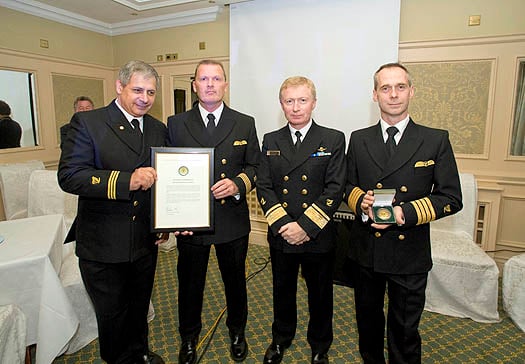
Top Brass: (from left to right) Paul Truss, Eamonn O'Broin, Chris Reynolds and Liam Flynn
The award recognises the personal commitment of all the crews, engineers and staff that have, over a period of two decades from 1991 to 2011, significantly enhanced Ireland's ability to affect a successful rescue and saved many lives.
It was accepted by Shannon Chief Pilot Captain Liam Flynn, Chief Crewman Eamonn O'Broin and Base Manager Paul Truss. Director of the Irish Coast Guard, Chris Reynolds, presented the award at a screening of a television documentary about the unit in Ennis.
The programme, called Rescue 115, will be aired on Irish channel RTE and will give people the opportunity to get an intimate view of what the crew does.
Mark Kelly, managing director of CHC in Ireland, said: "I would like to extend my heart felt congratulations to each and every member of the Shannon team past and present on the Directors Award in recognition of outstanding service to the State.
"The Directors Award is a very prestigious award which has only been given eight previous times.
"In presenting the award at the premiere of Rescue 115, Chris Reynolds spoke of the outstanding service given by the Shannon base and its staff to the State over the last twenty years, during which time it has carried out 3,732 missions.
"It is a well deserved recognition of two decades of tremendous courage, loyalty and dedication to providing a world class search and rescue service."
Earlier this year, a CHC SAR crew was recognised with a Best of Irish award for their role in successfully recovering the pilot of a light aircraft which crashed in the Irish Sea.
CHC Helicopter is the world's largest offshore helicopter operator and provides civilian search and rescue services in Ireland, the UK, Norway and Australia.




























